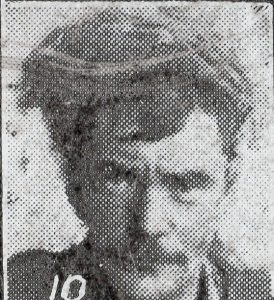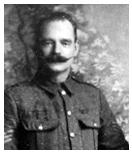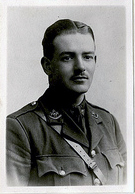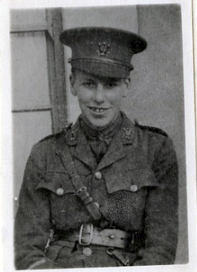.
Constitutional Club, Launceston War Memorial.
Alfred Martyn WILLIAMS
Alfred was born on the 14th of May 1897 to John Charles and Mary C Williams at Caerhayes Castle, St. Austell. His father was the Squire of Werrington estate. He joined the Royal Navy as a Midshipman and at the Wars beginning was serving aboard the ‘HMS Euryalus’. He was awarded the Distinguished Service Medal for his gallantry during the landings in the Dardanelles.
Members:
William Henry ADAMS

William was born in 1886 at 14 Hillpark Cottages, Launceston to Richard and Jane Adams. He had two Sisters and a Brother. In the 1911 census he is living at Woodbine Cottage, Launceston with his wife Ellen (nee Hill) having married on the19th of September 1910. Like his Father, William worked as a Mason. In 1915 he joined the Royal Engineers Pioneer 335th Road Construction Company (Regimental No 240305) as a reservist and was mobilized on the 16th of February 1917. At the time of his enlistment he was living at 3 Hendra Cottages, Launceston. He received multiple gunshot wounds on the 23rd of April 1917 which ended his war as he was discharged on the 15th of January 1918 as being no longer fit for military service. These wounds were so severe that he died just six days before the armistice on the 5th of November 1918 and he was buried at Launceston Cemetery. He left behind three children Sydney, Freda and William. Silver War Badge Number:
314761. He is commemorated on the Launceston War Memorial and the Wesleyan Roll of Honour.
T. H.T. BATE
No information available.
Lewis COLE
Lewis was born in 1896 to Thomas and Mary Ellen ‘Nellie’ Cole at Stoke Climsland, Near Callington. His Father was a House Painter and by the 1901 census had moved his family to Bush Park, Launceston. Lewis was artistic in nature and has a long association with the Launceston science and art school. In 1911 the family is living at 5 Garcia Terrace Launceston and Lewis having left school was working as an Architect’s Clerk with Messrs Wise and Wise in Launceston. Having served his time with Wise and Wise he moved to Wales to take up a position as an Architect.He enlisted as a Private with the Glamorganshire Yeomanry in Cardiff (Regimental No. 3051) but later transferred to the Royal Welsh Fusiliers 9th Battalion (Regimental No 75300). He was killed in action after a piece of shell struck him after it had exploded near his dugout the 18th of April 1918 in France. The German spring offensive that opened in March 1918 destroyed much of Fifth Army of which the 9th Battalion was part of. In the initial stages the 9th Battalion suffered over 450 casualties. Lewis body was never recovered but he is commemorated on the Launceston War Memorial and also the TYNE COT MEMORIAL Panel 63 to 65.
Stanley DOIDGE
Stanley was born in 1897 to Richard and Elizabeth Doidge at 40, St. Thomas Road, Launceston. His Father was a Newsagent a trade that Stanley followed into. He joined the Royal Army MedicalCorps on the 8th November 1915 as a Private (No 80912). He served as an ambulance driver in France from the 26th July 1916 till his death of pneumonia on the 28th October 1918 and is buried at the Duisans British Cemetery, Duisans, Departementdu Pas-de-Calais, Nord-Pas-de-Calais, France, Plot VIII. B. 43. His name is commemorated on the Launceston War Memorial and the Wesleyan Roll of Honour.
E. HARE
No information available.
Robert William Digory MADDEVER
Robert was born in 1893 to William and Margaret Maddever at 15 Duke Street, St. Stephens, Launceston. His Father was a General Carter (Timber Haulier). His Father died in 1911. He was educated at Horwell Boys Grammar School and Camelford Grammar School and went on to become a school teacher. According to reports he was a keen athlete being associated with Launceston Football, Cricket, Tennis and Bowling clubs. He first volunteered for active service with the Cornwall territorials on the 24th April 1915 and gained rapid promotion being made Quartermaster Sergeant on the 16th December 1915. He obtained a commission and was made 2nd Lieutenant of the Somersetshire Light Infantry 4th Battalion on the 20th of July 1917 with whom he fought with in France and Flanders from the 10th September 1917. He died near Ypres on the 22nd of October 1917 of wounds he received in action the same day during the Third Battle of Ypres. He is commemorated at the Tyne Cot Memorial, Zonnebeke, West Flanders (West-Vlaanderen), Belgium Panel 41 to 42 and 163A and also the Launceston War Memorial and St Stephens Roll of Honour. He left a widow in Margaret of 15, Duke St., St. Stephens, Launceston.
Charles MEDLAND
Charles was born in 1883 to Edwin and Grace Medland at Boscastle, Cornwall. His Father was a Mason. They moved to live at Chapple, Launceston before 1890. Charles followed his Father’s trade and worked as a Mason. Around 1910 Charles married Mary Emma ‘Emmie’ and they had two children Joseph and Charlie. They set up home also at Chapple. Charles enlisted with the DCLI as a Private (Regimental No. 540) and saw action during the Boer War in South Africa continuing his service there after peace was resumed. He was transferred to the Devonshire Regiment (Regimental No. 315796) serving with the 15th Battalion (Territorial). He rose to the rank of Sergeant. He was injured in battle and was evacuated to England although his injuries were critical. His Wife and Mother were advised to immediately travel if they wished to see him before he died, making it just before he passed away at Herne Bay on the 25th of May 1917. He was buried at Launceston Cemetery after a full military service. He is also commemorated on the Launceston War Memorial.
Richard MEDLAND
Richard was born in 1893 to Edwin and Grace Medland at St. Thomas, Launceston. His Brother Charles also perished in the war (above). His Father was a Wall Mason/ Builder. Richard became a Carpenter on leaving school. He emigrated to Canada on the 22nd of April 1913, arriving at Maine aboard the ‘Megantic’ from Liverpool. On the of 2nd January 1915 he enlists with First Canadian Mounted Rifles (Saskatchewan Regiment) Private No 108375 in Vegreville, Minburn, Alberta, Canada. Like so many in his Battalion, Richard was killed on the 5th of June 1916 during the Battle of Mont Sorrel. His body was never recovered but he is remembered on the Ypres Menin Gate Memorial as well as on the Launceston War Memorial.
The Battle of Mont Sorrel (Battle of Mount Sorrel, Battle of Hill 62) was a localized conflict of World War I between three divisions of the British Second Army and three divisions of the German Fourth Army in the Ypres Salient, near Ypres, Belgium, from 2 June 1916 to 14 June 1916. In an effort to pull British resources from the observed build-up in the Somme, the XIII (Royal Württemberg) Corps and the 117th Infantry Division attacked an arc of high ground positions defended by the Canadian Corps. The German forces initially captured the heights at Mount Sorrel and Tor Top before entrenching on the far slope of the ridge. Following a number attacks and counterattacks, two divisions of the Canadian Corps, supported by the 20th Light Division and Second Army siege and howitzer battery groups, recaptured the majority of their former positions.
William OWEN
William was born in 1892 at Langore, Launceston to William and Mary Owen. His Father was a Quarry Labourer. On leaving School, William became an Apprentice Painter. With his wife Bessie he set up home in Tower Street, Launceston. He joined the DCLI as a Private (Regimental No 260014/33664) serving with the 1st/5th Battalion. He died at home of injuries sustained in battle, possibly during the Germans retreat to the Hindenburgh Line, on the 12th of August 1917. He is buried at Launceston Cemetery.
H. PODE
No information available.
Charles Alfred PHELPS

Charles was born in 1876 to Henry and Alice Phelps at Cheltenham, Gloucestershire. His Father was a Railway Signalman. At the age of 14 he went and worked as a General Labourer for a retired Baker Mr. Huxham and his wife at Chaceley. He married Mary Jane Buckley and they had 7 Children. He joined the DCLI at around 1893 serving in many countries including South Africa where three of his Children were born. On leaving the DCLI he and his family moved to St. Thomas Road, Launceston where he became the commissionaire at the Launceston Picture Theatre in Northgate Street. On the outbreak of War, he was re-enlisted with the DCLI (Regimental No. 5981) as Company Sergeant Major.
He was killed by shell fire on the 31st July 1915. His body was never identified but his name in commemorated at the Ypres (Menin Gate) Memorial, Ypres (Ieper), West Flanders (West-Vlaanderen), Belgium, Panel 20 and the Launceston War Memorial.
FALLEN IN THE FIGHT (Extract from the Cornish and Devon Times)
COMPANY-SERGT-MAJOR PHELPS
Sympathy will be extended to Mrs. Phelps, St Thomas, Launceston, in the sad news which has reached her that her husband, Company-Sergt-Major Phelps, 6th DCLI* was killed in action near Hooge on 30 July. The sad intelligence comes after a long period of suspense and anxiety for Sergt Phelps over several months, though at one time it was reported, sadly without foundation – that he was wounded and in hospital.
The news now comes through the inquiry department of the Red Cross who write that they have received a report, dated 9th November, from Corpl Hilliard, 11569, now on leave in France, who states that Sergt Phelps was killed by shell fire in Sanctuary Wood, near Hooge. It was, Corpl Hilliard says, impossible to remove him at the time as there was so many lying about, but later they were able to bury the dead.
Company-Sergt-Major Phelps was of course well known to many of our readers having been for a considerable time the popular commissionaire at the Launceston Picture Theatre. Previously, he had been in the Army, serving in the South African and other campaigns and rejoining soon after the outbreak of the present war to one of the newly-formed DCLI battalions. A smart soldier, and a man of the friendliest disposition, his death in the service of his King and country is keenly regretted by his many acquaintances.
John Balhatchet SLEE
John was born in 1890 to William and Elizabeth (nee Balhatchet) Slee at Church Street, Launceston. Elizabeth died in 1894 when John was just four years old. His Father worked at the Launceston Savings Bank and was also Collector of taxes. By 1911 William had remarried Sophie and was a Bookseller and Stationer with John following into his Father’s business. For several years John was the Hon. Secretary for the Constitutional Club of Launceston and was also a keen member of Launceston’s Operatic Society and St. Thomas Church Choir. He initially enlisted with the R.F.A (107806) as a Lieutenant but later transferred to the DCLI 7th Battalion. He was slightly injured by a gunshot wound to his cheek but recovered and returned to the front. He was wounded during the German Spring Offensive on the 24th of March 1918 more seriously and taken to a field hospital which in turn was heavily shelled and John was killed. His body was never identified but his name is commemorated at the Pozieres Memorial, Pozieres, Departement de la Somme, Picardie, France, Plot: Panel 45. He is also commemorated on the Launceston War Memorial.
George Neal SPRY
George was born in 1894 to Daniel and Ann Spry at Boyton, Launceston. Boyton was in the county of Devon at this time. His Father was a Farmer and Butcher and the family was living at London House, Stowford in the 1901 census. By 1911 the family had moved to Market Street, Launceston and operated as Butchers which by this time George had joined. George married Elizabeth Medland (sister of Charles and Richard Medland) in 1915 at Launceston and in 1916 they had a Daughter Joyce. He appealed to the local tribunal to have his service enlistment cancelled but George’s final tribunal appeal was turned down. He enlisted with the Royal Engineer Corps at Launceston at the rank of DVR (Regimental No. 141221). He died whilst board the “Transylvania” in the Mediterranean near Savona, Italy on the 4th of May 1917.
On May 3 1917, the Transylvania sailed from Marseille to Alexandria with a full complement of troops, escorted by the Japanese destroyers Matsu and Sakaki. At 10 am on May 4 the Transylvania was struck in the port engine room by a torpedo fired by the German U-boat U-63 under the command of Otto Schultze. At the time the ship was about 2.5 miles (2.2 nmi; 4.0 km) south of Cape Vado near Savona, in the Gulf of Genoa. The Matsu came alongside the Transylvania and began to take on board troops while the Sakaki circled to force the submarine to remain submerged. Twenty minutes later a second torpedo was seen coming straight for the Matsu, which saved herself by going astern at full speed. The torpedo hit the Transylvania instead, which sank immediately. Ten crew members, 29 army officers and 373 soldiers lost their lives.
Many bodies of victims were recovered at Savona and buried two days later, in a special plot in the town cemetery. Others are buried elsewhere in Italy, France, Monaco and Spain. Savona Town Cemetery contains 85 Commonwealth burials from the First World War, all but two of them casualties from the Transylvania. Within the cemetery is the Savona Memorial which commemorates a further 275 casualties who died when the Transylvania sank, but whose graves are unknown. He is commemorated on the Savona Memorial, Launceston War Memorial and the Wesleyan Roll of Honour.
A. C. (Algernon Carteret) THYNNE
Possibly Algernon the son of Francis John Thynne, of Haynes Park, Beds born in 1868 but there is no other information available to confirm this; husband of Constance Thynne, of Penstowe, Kilkhampton, Bude, Cornwall. He served in the South African war. He was a Lieutenant Colonel with the 1st Battalion of the Royal North Devon Yeomanry. He was awarded the D.S.O. He died on November 6th, 1917 and was interred in the Beersheba Cemetery, Israel, Grave L. 60.
H. B. THORNHILL
No information available.
Sydney William THOMAS
Sydney was born in 1898 at Starr Cottage, Coombe Martin to William and Ellen Thomas. His Father was a General Agricultural Labourer. He married Dorothy and set up home at 3 Clarence Terrace, Launceston.
Before joining up he worked for Shuker and Reed. He initially enlisted in 1916 with the Duke of Cornwall’s Light Infantry (Regimental No. 30107) as a Private but was transferred to the 1st Battalion of the Wiltshire Regiment (Regimental No. 220042). He was killed in action during the Battle of Messines on the 7th of June 1917. His body was never identified but his name is commemorated at the Ypres (Menin Gate) Memorial , Ypres, West Flanders (West-Vlaanderen), Belgium and also on the Launceston War Memorial.
The Battle of Messines (June 7th-14th 1917) was conducted by the British Second Army (General Sir Herbert Plumer), on the Western Front near the village of Messines in West Flanders, Belgium, during the First World War. The Nivelle Offensive in April and May had failed to achieve its more ambitious aims, had led to the demoralisation of French troops and dislocated the Anglo-French strategy for 1917. The offensive at Messines forced the Germans to move reserves to Flanders from the Arras and Aisne fronts, which relieved pressure on the French. The tactical objective of the attack at Messines was to capture the German defences on the ridge, which ran from Ploegsteert (Plugstreet) Wood in the south, through Messines and Wytschaete to Mt. Sorrel, to deprive the German 4th Army of the high ground south of Ypres. The ridge commanded the British defences and back areas further north, from which the British intended to conduct the Northern Operation, an advance to Passchendaele Ridge and then capture the Belgian coast up to the Dutch frontier.
Leslie Henry Harvey TUCKER
Leslie was born in 1898 to George and Edith Tucker at St. Austell. His Father was an Agent for Pearl Life Assurance. By 1911 George had passed away and Edith had moved the family to 3 Bellevue, Westgate Street, Launceston. Leslie worked for W. H. Symons, jeweller in Church Street, Launceston. Leslie enlisted in May 1917 as a Driver with the Royal Horse Artillery and Royal Field Artillery Regiment (Regimental No. 238687). He died of his wounds on October 10th, 1917 whilst serving with the 298th Brigade. He is buried at the Mendinghem Military Cemetery, Poperinge, West Flanders (West-Vlaanderen), Belgium, Plot: VI. E. 7. He is commemorated on the Launceston War Memorial and the Royal Regiment of Artillery Memorial.
The Royal Field Artillery was the most numerous arm of the artillery, the horse-drawn RFA was responsible for the medium calibre guns and howitzers deployed close to the front line and was reasonably mobile. It was organised into brigades.
Edgar VOSPER
Edgar was born in 1893 to Charles and Emma Vosper at Banham, Launceston. His Father was a farmer and Butcher which was a trade that Edgar took up on leaving school. He joined the Royal 1st Devon Yeomanry (Hussars) as a Private (Regimental No. 2486). He died of dysentery in Egypt that he contracted whilst fighting at Gallipoli on November 2nd, 1915. He is buried at the Alexandria (Chatby) Military Cemetery, Alexandria Al Iskandariyah, Egypt, Plot: B. 133. He is commemorated on the Launceston War Memorial.
Darrell Francis Stephen VOWLER

The Battle of Vimy Ridge was part of the Battle of Arras, in the Nord-Pas-de-Calais region of France, during the First World War. The main combatants were the four divisions of the Canadian Corps in the First Army, against three divisions of the German 6th Army. The battle took place from April 9th-12th 1917 at the beginning of the Battle of Arras, the first attack of the Nivelle Offensive, which was intended to attract German reserves from the French, before their attempt at a decisive offensive on the Aisne and the Chemin des Dames ridge further south.

Visits: 87
